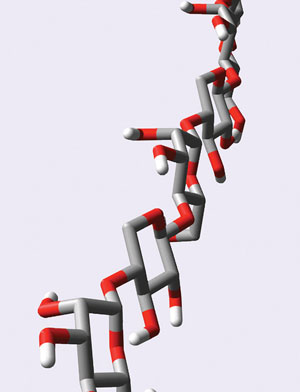Mar. 2, 2012 Research Highlight Biology Chemistry
Building a beetle antifreeze
An Alaskan beetle beats the cold using an unusual, natural antifreeze with a novel mode of action that scientists are beginning to unravel
 Figure 1: A computer-generated image of the beetle antifreeze xylomannan reveals that one face bristles with oxygen atoms (red), forming a polar surface that helps it to cling to ice crystals. © 2012 Yukishige Ito
Figure 1: A computer-generated image of the beetle antifreeze xylomannan reveals that one face bristles with oxygen atoms (red), forming a polar surface that helps it to cling to ice crystals. © 2012 Yukishige Ito
Animals and plants have evolved all sorts of chemical tricks that allow them to colonize extreme environments. For species that call Antarctica or the Arctic home, surviving sub-zero temperatures is an essential ability, and chemists have isolated many natural antifreeze compounds from these organisms. The antifreeze called xylomannan, which is produced by the freeze-tolerant Alaskan beetle Upis ceramboides, is being studied by Akihiro Ishiwata and Yukishige Ito at the RIKEN Advanced Science Institute at Wako and their colleagues. Their findings to date show that xylomannan is a particularly unusual antifreeze1.
Xylomannan was first reported in 2009, and has been shown to be amongst the most active insect antifreezes found to date2. Antifreeze compounds, which are also known as thermal hysteresis factors (THFs), protect the insects’ cells from damage as temperatures fall and ice crystals begin to form. THFs seem to work by sticking to the surface of nascent ice crystals and somehow stopping them from growing, protecting nearby cell membranes from being punctured by needles of ice.
The unusual thing about xylomannan is its constituents. Every natural THF isolated to date is protein based, but xylomannan is a glycan, a long-chain sugar-based compound. “Xylomannan is the first example of a THF biomolecule with little or no protein component,” says Ishiwata. “Its mode of action is not entirely clear, but it should be different to those of common THFs such as antifreeze proteins and glycoproteins.”
To confirm the proposed structure of xylomannan, so that they can begin to study how it interacts with ice crystals, Ishiwata, Ito and their colleagues synthesized what they thought to be a key component of the compound’s sugar-based backbone. Their structural analysis, using nuclear magnetic resonance techniques and molecular modeling, confirmed that the structure matches that of the natural compound. It also hints at the way that xylomannan might stick to ice crystals: one face of xylomannan is much more polar than the other face, making one face hydrophilic and the other hydrophobic (Fig. 1).
“We propose that the hydrophilic phase of xylomannan might bind to the ice crystal, exposing the hydrophobic phase on the ice crystal’s surface,” says Ishiwata. This hydrophobic surface should repel water molecules away from the ice crystal, stopping it from growing any further. “However, the binding mode is still not clear from our structural analysis,” he adds. To test the theory further, the team now plans to synthesize longer fragments of xylomannan to examine their ice-binding ability.
References
- 1. Ishiwata, A., Sakurai, A., Nishimiya, Y., Tsuda, S. & Ito, Y. Synthetic study and structural analysis of the antifreeze agent xylomannan from Upis ceramboides. Journal of the American Chemical Society 133, 19524–19535 (2011). doi: 10.1021/ja208528c
- 2. Walters, K.R. Jr., Serianni, A.S., Sformo, T., Barnes, B.M., Duman, J.G. A nonprotein thermal hysteresis-producing xylomannan antifreeze in the freeze-tolerant Alaskan beetle Upis ceramboides. Proceedings of the National Academy of Sciences USA 106, 20210–20215 (2009). doi: 10.1073/pnas.0909872106
